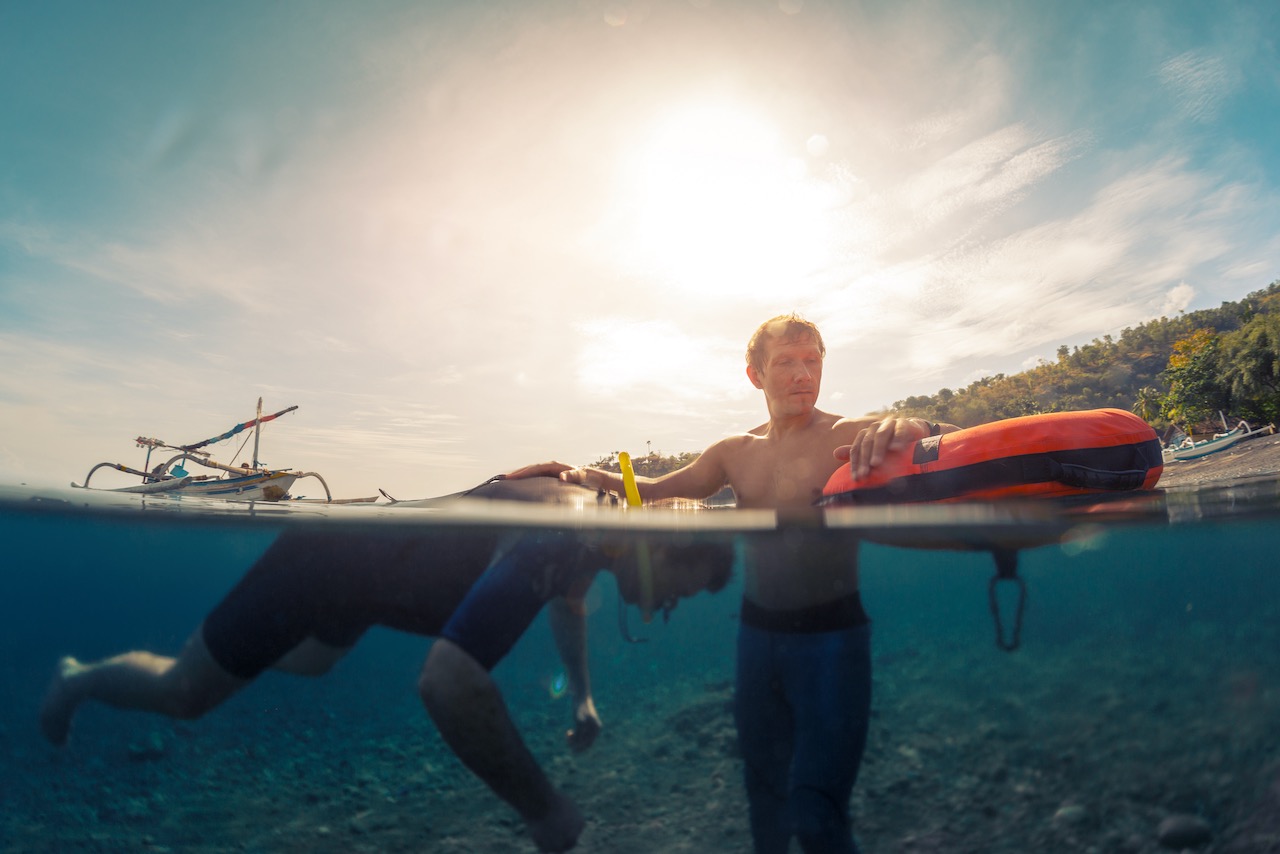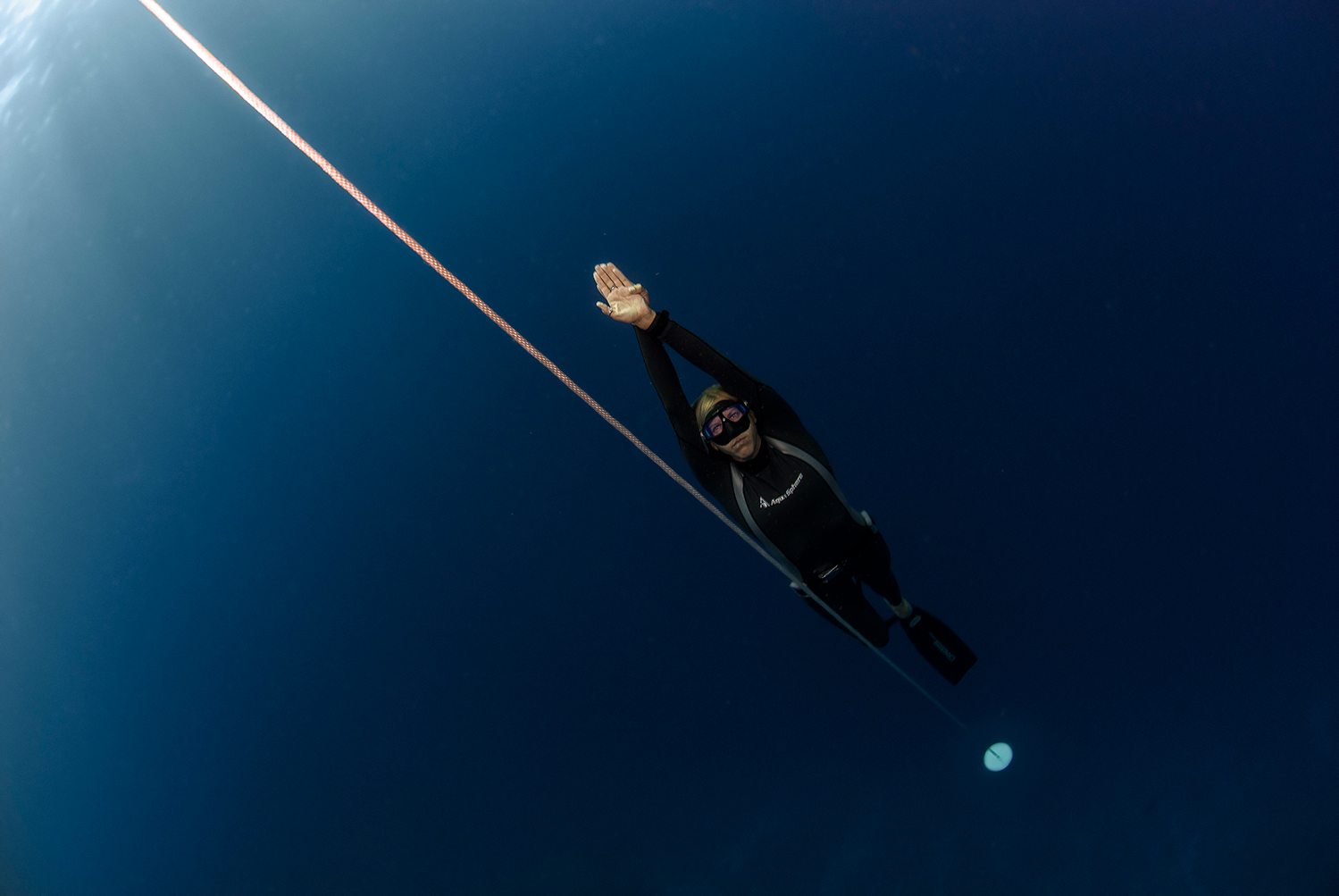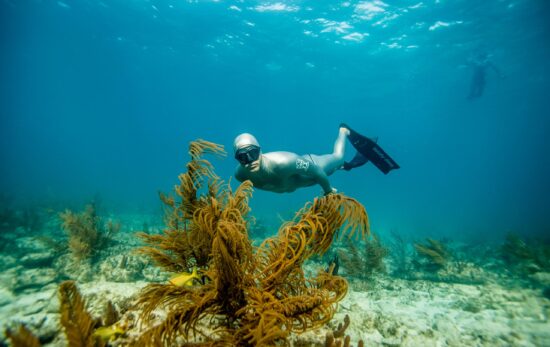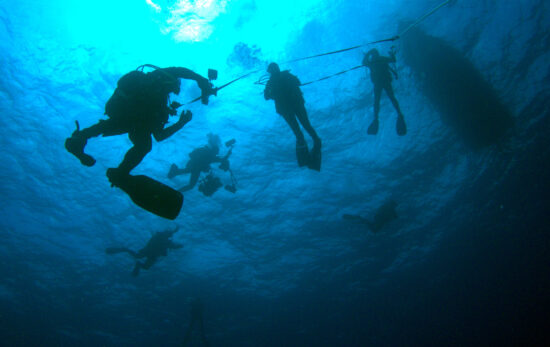Before and after Freediver training, the number one question many people have is how to hold your breath longer underwater. In this blog, we’ll go through some tips and tricks for extending your breath holds.

Train to Hold Your Breath on Land
There are a couple different ways to train to hold your breath on land. The most common ways would be to do static breath holds or dynamic breath holds, like apnea walks.
Whichever you choose, during each training session, we will need to think about either our CO2 tolerance or our O2 threshold. In order to determine what you should target we need to figure out what is your limiting factor during your breath hold.
- If you feel the urge to breathe come on quickly and/or it becomes too uncomfortable to continue, you will most likely want to focus on training your CO2 tolerance.
- If you are able to keep a deep relaxation for most of your breath hold and the urge to breathe is not overwhelming but you are starting to become hypoxic (having too little oxygen) and end the breath hold, you will most likely want to focus on training your O2 threshold.
Most freedivers just starting out will want to focus training their CO2 tolerance. However, please note that this is most likely not the limiting factor to your breath hold.
You will also want to focus on how you prepare for your breath hold. You’ll want to take a proper complete breath before a breath hold. And, you’ll want to check on your mental state during the breath hold.

Develop a Deeper State of Relaxation Before You Dive
Many Freedivers take their first Freediving course and are excited to learn the “secrets” of how to breathe for Freediving. It may seem underwhelming to learn the best thing a beginner can do before their dives is to not think about their breathing! That’s right; you want to breathe exactly as your breathing while reading this blog. We call this “Tidal Breathing.”
While there are many interesting ways to practice breath work techniques that are beneficial for breath control and Freediving, we generally only use them for training purposes. One of the reasons being, if you’re thinking about your breathing, you’re using more oxygen! The exact opposite of what we want to achieve.
What we really want to do before our dive is a body scan. In order to do this we need to be in a relaxing position. To practice, close your eyes and on every inhale, focus on a body part and imagine a warm light from a flame. As you go to exhale, feel this flame diminish from that area and take the muscular tension away as well. Then on the next inhale, move down to the next body part and repeat until you get rid of all the tension in your body.
At this point, you can start defocusing your mind. This is easier said than done. I personally like to use a technique called mindfulness. Mindfulness is a type of meditation in which you focus on being intensely aware of what you’re sensing and feeling in the moment, without interpretation or judgment. In layman terms, just be present in the moment and let all thoughts leave your mind as easy as they came in.
In practice, we can pick out a noise, like the wind, waves, heartbeat or music, depending on the environment and just listen. Anytime you have a new thought come into your mind, you let it leave and keep the mind focused on the original noise. Your mind will always wander after a certain time. However, with a bit of practice you will be able to stay in this mindful state for a longer period of time.

Take a Complete Breath Before Your Dive
It’s easy to understand that the more air we have in our bodies, the longer we will be able to hold our breath. This is correct. However, what’s even more important is that we keep our relaxed state of body and mind while taking a complete breath before and during the entire breath hold.
There are two sections (or compartments) that we want to focus on while taking a complete breathe. We always want to start at the bottom and move the diaphragm down to allow air to fill the lowest parts of our lungs. After all, this is where the gas exchange is taking place. Then, we move up a bit to our thoracic cavity or ribcage. We first want to expand the ribcage to the sides and then lift it up in order for our lungs to be filled with the most air possible.
One very important step that is often overlooked is – once you have this full breath, you will need to take a couple seconds to relax again before you continue to dive. Your diaphragm will need to be lowered again to a resting position, and you will want to drop your shoulders.
To train for this, we can isolate the two compartments we need to fill for a complete breath, and then just breathe for at least two minutes using one section and leaving the other one neutral. For example:
- Breathe with the diaphragm and leave the thoracic cavity neutral; or
- Breath with the thoracic cavity and leaving the diaphragm neutral.
Another great way is to continuously take very slow and exaggerated complete breathes. One full cycle from full inhale to full exhale could take 30 second or even over one minute. However, you should be able to consistently keep the same pace and never have an urge to breathe.
The more control and mobility we have in the diaphragm and thoracic cavity, the more air we can take with us on a dive.

Work on Your Diving Technique
During freedives, there are many motor skills you must learn in order to dive efficiently and not waste your oxygen. From the start of the dive, you will want to have a very fluid and smooth transition from being horizontal on the surface to being vertical underwater. Most people call this the duck dive or dolphin dive, and perfecting it will make a huge difference to how long you can hold your breath underwater.
Once you’re completely underwater, you will also want to have a streamlined position such as:
- Head in a neutral position
- Shoulders and torso pointing the direction of travel
- One hand resting to the side and the other hand near the nose to equalize (make sure your elbow is tucked in and vertical)
- Pelvis and hips locked forward
- Ankles pointed during both your forward kick and backwards kick
Furthermore, let’s not forget that you will need to have an efficient kick. What this means can change greatly from diver to diver as there are many variables. However, some of the basics are:
- Start the dive with a more frequent and forceful kicking pattern and slowly reduce both until you hit your free fall depth.
- On the way back up, start with a more frequent and forceful kicking pattern and slowly reduce both. Once you’re 5 meters or 15 feet from the surface. you can float up using your buoyancy.
- Maintain equal force on the forward kicks and backward kicks.
- Move your legs from the hips with knees slightly bent.
- Point your feet/ankles during both your forward and backward kicks.
These are just a few of the best tips for learning to hold your breath longer underwater. But, the best advice is to continue to train every day to see improvements over time. If you’re already a PADI Freediver, sign up for the Advanced Freediver course now or find out what it takes to become a Master Freediver by clicking the button below.
Author Biography – Brad Stephens
This article was written by guest blogger Brad Stephens, PADI Freediving Instructor Trainer.
Brad is a PADI Freediving Instructor Trainer who runs a freediving school in Costa Rica, called Rica Freedivers. He is passionate about sharing his knowledge about the ocean and freediving to create well educated and responsible freedivers.




